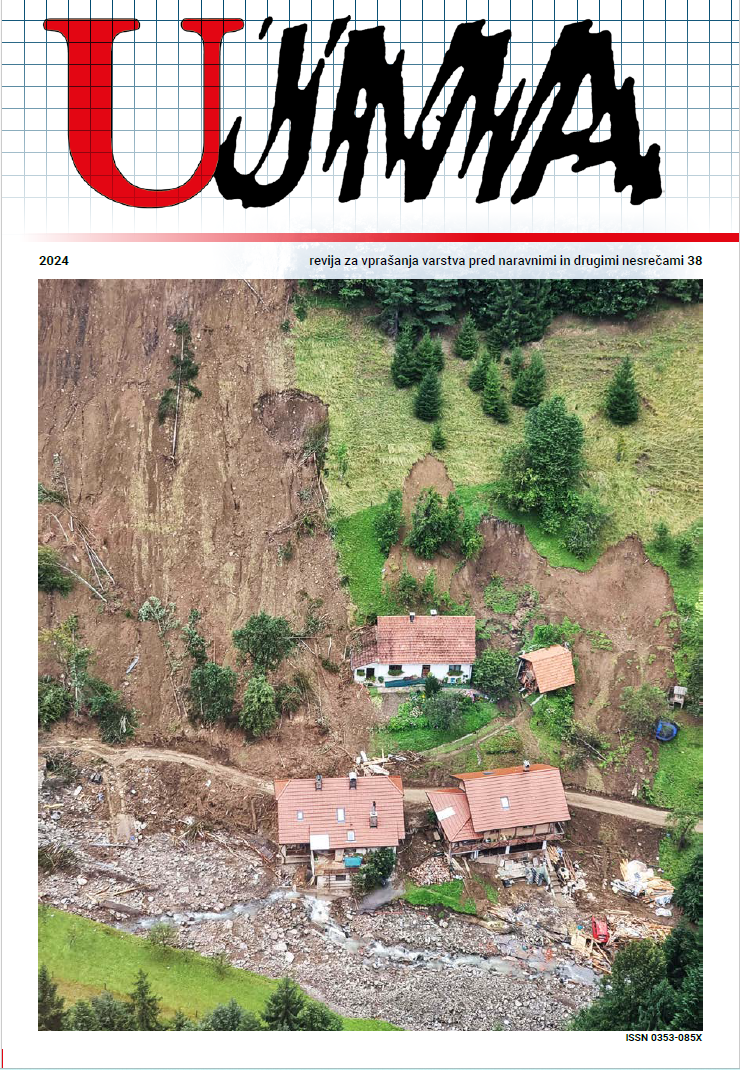SPONTANEOUS VOLUNTEERING
Abstract
In Slovenia, we have witnessed numerous natural disasters that have shaped the lives of people in the affected areas. Floods, earthquakes, hailstorms, and landslides have not only caused destruction but also sparked an immense desire for assistance from individuals – spontaneous volunteers. This review article addresses the phenomenon of spontaneous volunteering, explaining its characteristics and motives, and the behavioural patterns of people who find themselves at the scene of a natural disaster. Researchers have identified several archetypes of convergent behaviour in the past few decades, which are crucial to understand when planning the response of spontaneous volunteers to natural and other disasters. The article also presents five priority areas – local specificities, coordination, communication, training, and safety – that should be given attention when managing spontaneous volunteers, as well as the challenges this invaluable type of help poses for response leaders. We also outline some challenges for response management systems, which should be addressed in the future. A better understanding of the phenomenon of spontaneous volunteering will contribute to informed management and coordination of spontaneous volunteers by organizations involved in Civil Protection, as well as potential local coordinators of newly established groups.
References
Spontaneous Volunteers (AIDR 2017). https://knowledge.aidr.org.au/media/5618/aidr-communities-responding-to-disasters-planning-for-spontaneous-volunteers-handbook.pdf
Barut, D. (2023). Primer praktične uporabe sistema vodenja odziva na dogodek v Občini Logatec. Ujma, 37, 234–239.
Bunker, D., Mirbabaie, M., Stieglitz, S. (2017). Convergence Behaviour of Bystanders: An Analysis of 2016 Munich Shooting Twitter Crisis Communication.
Corporation for National and Community Service, Hands on Network, & Points of Light Foundation (2018). Managing Spontaneous Volunteers in Times of Disaster (Participant Materials). Corporation for National and Community Service. https://www.humanitarianlibrary.org/sites/default/files/2020/08/hon-cncs-msvtd_participant_materials.pdf
Daddoust, L., Asgary, A., McBey, K. J., Elliott, S., Normand, A. (2021). Spontaneous volunteer coordination during disasters and emergencies: Opportunities, challenges, and risks. International Journal of Disaster Risk Reduction, 65. https://doi.org/10.1016/j.ijdrr.2021.102546
EESC (2021). New trends in the development of volunteering in the European Union -Study. https://doi.org/10.2864/267828
Hutton, N. S., Mumford, S. W., Saitgalina, M., Yusuf, J. E., Behr, J. G., Diaz, R., Kiefer, J. J. (2021). Nonprofit Capacity to Manage Hurricane-Pandemic Threat: Local and National Perspectives on Resilience during COVID-19. International Journal of Public Administration, 44 (11–12), 984–993. https://doi.org/10.1080/01900692.2021.1922439
Jaime, D., Martínez, P., Contreras, D., Bonacic, C., Marín, M. (2023). Volunteers’ capabilities and their perceived satisfaction and performance in volunteering tasks during socio-natural disasters. International Journal of Disaster Risk Reduction, 85. https://doi.org/10.1016/j.ijdrr.2022.103510
Kebe, R. (2007). Arhetipi in kolektivno nezavedno. Kairos – slovenska revija za psihoterapijo, 1 (3–4). https://www.kairos.skzp.org/index.php/revija/article/view/28
Koolen-Maas, S. A., Meijs, L. C. P. M., van Overbeeke, P. S. M., Brudney, J. L. (2023). Rethinking Volunteering as a Natural Resource: A Conceptual Typology. Nonprofit and Voluntary Sector Quarterly, 52 (1_suppl), 353S-377S. https://doi.org/10.1177/08997640221127947
Malešič, M. (2020). Improviziran odziv na nesrečo. Ujma, 34–35, 299–304.
Orloff, L. (2011). Managing Spontaneous Community Volunteers in Disasters. CRC Press. https://doi.org/10.1201/b11078
Paciarotti, C., Cesaroni, A. (2020). Spontaneous volunteerism in disasters, managerial inputs and policy implications from Italian case studies. Safety Science, 122. https://doi.org/10.1016/j.ssci.2019.104521
Paciarotti, C., Cesaroni, A., Bevilacqua, M. (2018). The management of spontaneous volunteers: A successful model from a flood emergency in Italy. International Journal of Disaster Risk Reduction, 31, 260–274. https://doi.org/10.1016/j.ijdrr.2018.05.013
Points of Light Foundation, N. U. F. (2018). Managing Spontaneous Volunteers in Times of Disaster: The Synergy of Structure and Good Intentions. Points of Light Foundation. https://www.humanitarianlibrary.org/sites/default/files/2020/08/ManagingSpontaneousVolunteers.pdf
Rodríguez-Espíndola, O., Albores, P., Brewster, C. (2018). Disaster preparedness in humanitarian logistics: A collaborative approach for resource management in floods. European Journal of Operational Research, 264(3), 978–993. https://doi.org/10.1016/j.ejor.2017.01.021
Sperling, M., Schryen, G. (2022). Decision support for disaster relief: Coordinating spontaneous volunteers. European Journal of Operational Research, 299(2), 690–705. https://doi.org/10.1016/j.ejor.2021.08.022
Twigg, J., Mosel, I. (2017). Emergent groups and spontaneous volunteers in urban disaster response. Environment and Urbanization, 29(2), 443–458. https://doi.org/10.1177/0956247817721413
United Nations (2021). State of the World’s Volunteerism Report 2022 Building Equal and Inclusive Societies. https://www.un-ilibrary.org/content/books/9789210012416
Van Wassenhove, L. N. (2006). Blackett memorial lecture humanitarian aid logistics: Supply chain management in high gear. Journal of the Operational Research Society, 57(5), 475–489. https://doi.org/10.1057/palgrave.jors.2602125
Verhoeven, P., Tench, R., Zerfass, A., Moreno, A., Verčič, D. (2014). Crisis? What crisis? How European professionals handle crises and crisis communication. Public Relations Review, 40(1), 107–109. https://doi.org/10.1016/j.pubrev.2013.10.010
White, H. P. (2016). Understanding the role of spontaneous volunteers in disaster: The case study of the World Trade Centre on 9/11.
Downloads
Published
Issue
Section
License
Copyright (c) 2025 Ujma

This work is licensed under a Creative Commons Attribution-NonCommercial-NoDerivatives 4.0 International License.
The articles are made available to the public under Creative Commons Attribution-NonCommercial-NoDerivatives 4.0 International (CC BY-NC-ND 4.0).


